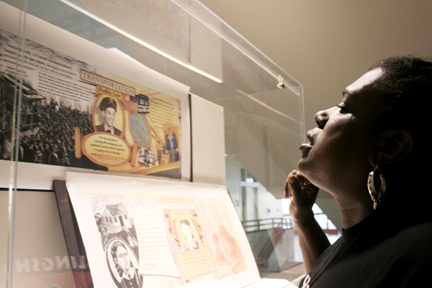College showcases African-American history with talks and exhibits

By Emily Daly
The Guardsman
City College is recognizing African-American History Month with a series of lectures on this year’s theme, “African-Americans and the Civil War.”
Presentations on the topic began Feb. 10 at three City College campuses, with additional lectures scheduled for Feb. 22 to 24. In addition, the Rosenberg Library is featuring a civil rights archive exhibit.
Underground Railroad
Guy Washington of the National Park Service presented the Feb. 10 slide show on the Underground Railroad in California.
Washington, a former peace corps member who served two years in Sierra Leone, Africa, started by noting that the origins of African American History Month date back to 1926 when historian Carter Woodson devoted himself to preserving his people’s history and organizing a week-long celebration in February. Fifty years later, President Gerald Ford extended that week to a whole month.
The slide show went over notable participants in the Underground Railroad, such as Harriet Tubman, Frederick Douglas and Rev. Jeremiah Sanderson.
“It’s a metaphor — it’s not BART, not the subway,” Washington said in regard to the railroad. The audience laughed.
He explained that the antislavery movement was divided into two groups — those who believed change could be made through political laws, and those who believed moral law was more important and wouldn’t wait for politics. Participants in the Underground Railroad were part of the second group.
Some of the Underground Railroad’s most important history took place near San Francisco. Many southern slaves who traveled through California during the gold rush were freed by anti-
slavery judges and sheriffs, and many slaves were able to buy their freedom by mining gold, Washington said.
Mary Ellen Pleasant, the head of the Underground Railroad in California, has a memorial plaque dedicated to her on the sidewalk at the corner of Octavia and Bush streets.“Slavery is not over yet,” Washington said at the end of the lecture. He explained that as many as 25 million people are currently enslaved in sweat shops and the sex industry.
“Why do we study this?” he asked. “Because we face it in our lives. It is our issue, and the issue of future generations.”
Buffalo Soldiers
Frederik Penn, also from the National Park Service, gave the Feb. 15 lecture “Buffalo Soldiers, From the Presidio to the National Parks.”
More than 100,000 Buffalo Soldiers fought in the Civil War. This was the name Native Americans gave to black soldiers because of their tenacity in battle, Penn said.
Penn’s lecture went over the reconstruction of the country after the Civil War, suggesting that if the Buffalo Soldiers had been sent to the South to enforce the policies of the reconstruction, America could be a very different place than it is today. Buffalo Soldiers were instead sent west to pacify Native Americans, who were fighting for their own rights.
Penn stressed that if it were not for the struggles of African Americans, America would be far away from its ideals of justice, liberty and equality, and the nation’s democracy would not be as powerful.
Upcoming
Milton Bowens will give the Feb. 23 lecture, “Cultural Legacy of the Civil War.” Stan Yogi and Elaine Elinson will lead the Feb. 24 reading and discussion of their book, “Wherever There’s a Fight,” detailing the contributions of runaway slaves, suffragists and immigrants
in California.
The Rosenberg Library is hosting an exhibit curated by Nancy Simon from the Labor Archives and Research Center and the archives at the San Francisco History Center until April 15. Titled “Occupation! Economic Justice as a Civil Right in San Francisco,” the exhibit features a collection of photographs by Phiz Mezey, as well as a time line of major civil rights events in San Francisco.
The exhibit focuses on 1963 and 1964, when many civil rights demonstrations began in San Francisco at places such as Mel’s Diner, the Sheraton Palace Hotel and car dealerships on Van Ness Avenue. The protesters were challenging the discriminatory hiring practices of these businesses.
Over 220 demonstrators were arrested during an April 1964 protest at the Weissman Lincoln Mercury Dealership at 1301 Van Ness Ave., the most people arrested in a non-southern civil rights rally.
“If we did not look at or study African American history, we would not be fully aware of our rights as citizens,” Penn said. “Thanks to the hard work, cooperation and sacrifices of so many African Americans and progressive white citizens, America today is closer to realizing the promise of the Declaration of Independence.”
Email:
edaly@theguardsman.com

Comments are closed.